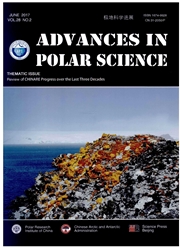

 中文摘要:
中文摘要:
The annual cycle of the thickness and temperature of landfast sea ice in the East Siberian Sea has been examined using a one-dimensional thermodynamic model. The model was calibrated for the year August 2012–July 2013, forced using the data of the Russian weather station Kotel’ny Island and ECMWF reanalyses. Thermal growth and decay of ice were reproduced well, and the maximum annual ice thickness and breakup day became 1.64 m and the end of July. Oceanic heat flux was 2 W.m–2 in winter and raised to 25 W.m–2 in summer, albedo was 0.3–0.8 depending on the surface type(snow/ice and wet/dry). The model outcome showed sensitivity to the albedo, air temperature and oceanic heat flux. The modelled snow cover was less than 10 cm having a small influence on the ice thickness. In situ sea ice thickness in the East Siberian Sea is rarely available in publications. This study provides a method for quantitative ice thickness estimation by modelling. The result can be used as a proxy to understand the sea ice conditions on the Eurasian Arctic coast, which is important for shipping and high-resolution Arctic climate modelling.
 英文摘要:
英文摘要:
The annual cycle of the thickness and temperature of landfast sea ice in the East Siberian Sea has been examined using a one-dimensional thermodynamic model. The model was calibrated for the year August 2012-July 2013, forced using the data of the Russian weather station Kotel'ny Island and ECMWF reanalyses. Thermal growth and decay of ice were reproduced well, and the maximum annual ice thickness and breakup day became 1.64 m and the end of July. Oceanic heat flux was 2 W.m^-2 in winter and raised to 25 W.m^-2 in summer, albedo was 0.3-0.8 depending on the surface type (snow/ice and wet/dry). The model outcome showed sensitivity to the albedo, air temperature and oceanic heat flux. The modelled snow cover was less than 10 cm having a small influence on the ice thickness. In situ sea ice thickness in the East Siberian Sea is rarely available in publications. This study provides a method for quantitative ice thickness estimation by modelling. The result can be used as a proxy to understand the sea ice conditions on the Eurasian Arctic coast, which is important for shipping and high-resolution Arctic climate modelling.
 同期刊论文项目
同期刊论文项目
 同项目期刊论文
同项目期刊论文
 Assessment of Arctic sea ice concentration retrieval based on HY-2 scanning radiometer data using fi
Assessment of Arctic sea ice concentration retrieval based on HY-2 scanning radiometer data using fi 期刊信息
期刊信息
